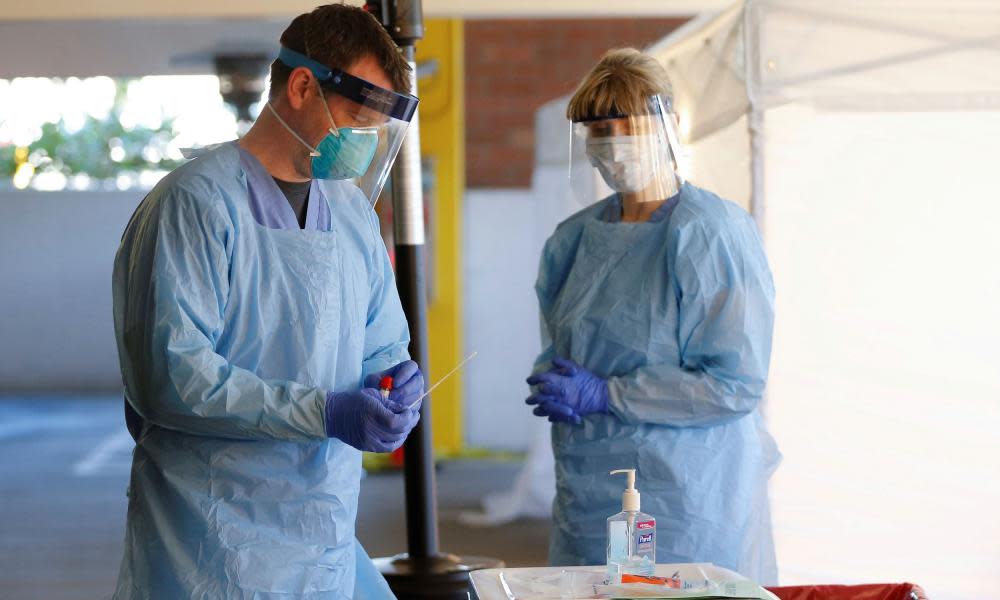Shifting guidelines on coronavirus treatment in US could be ‘catastrophic’

While frontline healthcare workers fighting the US coronavirus outbreak continue to struggle with what they have called a dramatic lack of preparedness, ever-shifting guidelines on treatment are raising concerns that America’s response is dangerously inconsistent.
Nurses working amid this outbreak – which continues to see increasing numbers of diagnoses and deaths – maintain that the guidelines keep shifting due to fluid federal mandates and continued staffing and supply shortages.
Of more than 6,500 nurses across 48 states, Washington DC and the Virgin Islands recently surveyed by National Nurses United (NNU), just 44% said their employers had given them information on novel coronavirus and “how to recognize and respond to possible cases”. A mere 63% of nurses surveyed had access to N95 masks in their divisions, while just 27% had access to powered air purifying respirators.
Less than one-third – 30% – of survey participants reported that their employers had enough personal protective equipment (PPE) in stock should there be a quick upswing in potential coronavirus patients.
An emergency room nurse at a private hospital in New York City’s Bronx borough told the Guardian last week that access to certain respirators had been curtailed, and said available masks would not necessarily fit.
“We are starting to see all the hospitals get in line to undermine the precautions that should be in place,” said David Pratt, a New York State Nurses Association health and safety representative, explaining the growing pushback against inconsistent information. “There are different things being said.”
Pratt claimed that a whistleblower told his organization that healthcare employers were pushing the federal public health agency, the Centers for Disease Control and Prevention (CDC), to loosen protection guidelines – which, in turn, would change them.
“It’s not just coronavirus, but a virus that can spread through contact as well as through droplets,” Pratt said. “Employers have been pushing to get the CDC to back off on the requirement that, for example, the nurses and other staff use N95 respirators.”
Some employers want healthcare staff to reuse N95 masks, a particular type of mask. Pratt said this is “not kosher when we have contact or droplet exposure to a piece of protective equipment”.
Initially, federal guidance said that nurses caring for a coronavirus patient could only deal with that patient; now, nurses are permitted to work with other patients, Pratt said.
“There’s not enough clear, strong directives coming from anywhere,” he said.
“It’s extremely dangerous – it could be catastrophic,” Pratt said of the lack of steady guidance. “But, hopefully, we’re not going to be in that situation”
Marcia Santini, an emergency room nurse at the University of California Los Angeles hospital, said there are “inconsistencies” in policies even within the state’s university hospital system.
“The administrators, now that we have declared a state of emergency in California, they’re keeping up with whatever the CDC is putting out, and that changes day-to-day,” she said.
Santini said later that federal officials aren’t giving healthcare facilities all the facts, exacerbating this situation.
“We’re not getting the truth,” she said. “And then hospitals, their hands are kind of tied because they’re trying to follow the guidelines, and the guidelines keep changing.
“There is a lot of common sense that should be put into this,” she said of a proper approach to coronavirus. “It’s not rocket science – you need to be protected.”
Santini said that coronavirus patients should be treated very seriously – “as though we were dealing with someone with tuberculosis”. But decision-makers are not doing this, due to shifting guidelines and ongoing supply and staffing problems, she added.
“Because we’re in short supply of protection, I think that they’re making their decisions based on that, which is wrong,” she said. “For example, the infectious department came down to the emergency room and saw nurses were wearing masks, and then went up to them and said, ‘why?’
“They said, ‘no, take the mask off, because you might be causing more problems by wearing one than not,” she continued. “So, I think that a lot of our decisions that the hospitals are making across the country are based on, unfortunately, your resources – whether it’s staff, whether it’s supply.”
“They don’t realize, if one of us gets sick you’re not going to have nurses to take care of patients if we have to get quarantined,” she said.
Further, Santini said uncertainty about coronavirus trickles down to the public which, in turn, affects medical facilities.
“You get mixed messages from the news, or from the government, you get people that panic and think they have it,” she said. “And they come, and it makes it difficult, just number-wise.
“If people are coming in and they don’t really need to be there, we need to send clear messages to the public: do not go to the emergency room,” she said. “Call your doctor. Call a hotline. We’ll guide you on what to do.”

